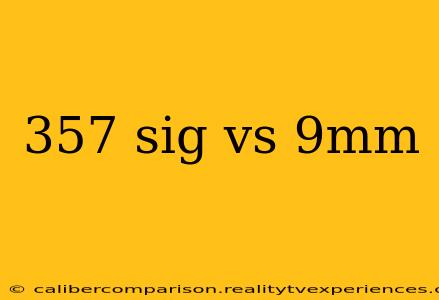Choosing the right caliber for self-defense or personal protection is a crucial decision, and the debate between .357 SIG and 9mm often arises. Both are popular choices, but understanding their distinct characteristics is vital for making an informed choice. This in-depth comparison will analyze ballistics, recoil, capacity, cost, and suitability for different applications to help you determine which caliber best fits your needs.
Ballistics: Power and Penetration
The key difference between .357 SIG and 9mm lies in their ballistic performance. The .357 SIG boasts significantly higher muzzle energy and velocity than the 9mm, translating to greater stopping power at longer ranges. This increased energy delivers more forceful impact upon target impact, potentially leading to quicker incapacitation.
However, the 9mm shouldn't be underestimated. While less powerful, advancements in projectile technology, such as jacketed hollow points (JHPs), have dramatically improved its stopping power. Modern 9mm JHPs expand reliably, creating larger wound cavities and maximizing energy transfer within the target.
In short: .357 SIG delivers more raw power, while the 9mm offers a balance of power and manageable recoil with modern ammunition advancements.
Penetration: A Crucial Factor
Penetration is another critical aspect to consider. The higher velocity of the .357 SIG can lead to over-penetration, posing a risk to bystanders or unintended targets if the bullet passes through the intended target. Conversely, the 9mm, particularly with well-designed JHPs, often offers a better balance between penetration and expansion, maximizing stopping power without excessive penetration.
Recoil and Shootability
The increased power of the .357 SIG comes at a cost: significantly more recoil. This stronger recoil can make it more challenging for novice shooters to control, potentially impacting accuracy and follow-up shots. The 9mm, on the other hand, is known for its manageable recoil, making it more comfortable to shoot, even for extended periods. This translates to faster target acquisition and more accurate shooting, especially in stressful situations.
Capacity: Rounds per Magazine
Generally, 9mm handguns offer higher magazine capacities than .357 SIG pistols. This translates to more rounds available in a self-defense scenario, providing a potential advantage. While .357 SIG magazines are available in various capacities, the 9mm usually holds more ammunition.
Cost: Ammunition and Firearms
.357 SIG ammunition tends to be more expensive than 9mm ammunition. This cost difference can be substantial over time, especially with frequent practice or range sessions. Similarly, .357 SIG firearms often command a slightly higher price than comparable 9mm handguns.
Suitability for Different Applications
-
Self-Defense: Both calibers are suitable for self-defense. The .357 SIG's higher stopping power might be favored by some, but the 9mm's manageable recoil and higher capacity could be more advantageous for others. The choice depends on individual preferences and shooting proficiency.
-
Concealed Carry: The 9mm's generally smaller and lighter firearms make it a popular choice for concealed carry, while the .357 SIG's increased recoil and potentially higher cost might deter some users.
-
Law Enforcement: While both calibers are used by law enforcement, the 9mm's prevalence is far more widespread due to its manageable recoil, higher capacity, and lower cost per round.
Conclusion: Choosing the Right Caliber
Ultimately, the "better" caliber depends on individual needs and preferences. The .357 SIG offers greater stopping power but comes with increased recoil and higher cost. The 9mm provides a balance of manageable recoil, higher capacity, affordability, and good stopping power with modern ammunition. Consider your shooting experience, intended use, and budget when making your decision. Thorough research and practical experience at a shooting range are crucial for making the most informed choice.

